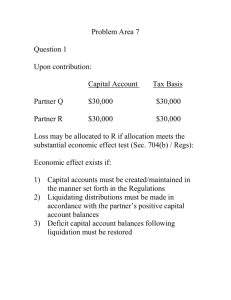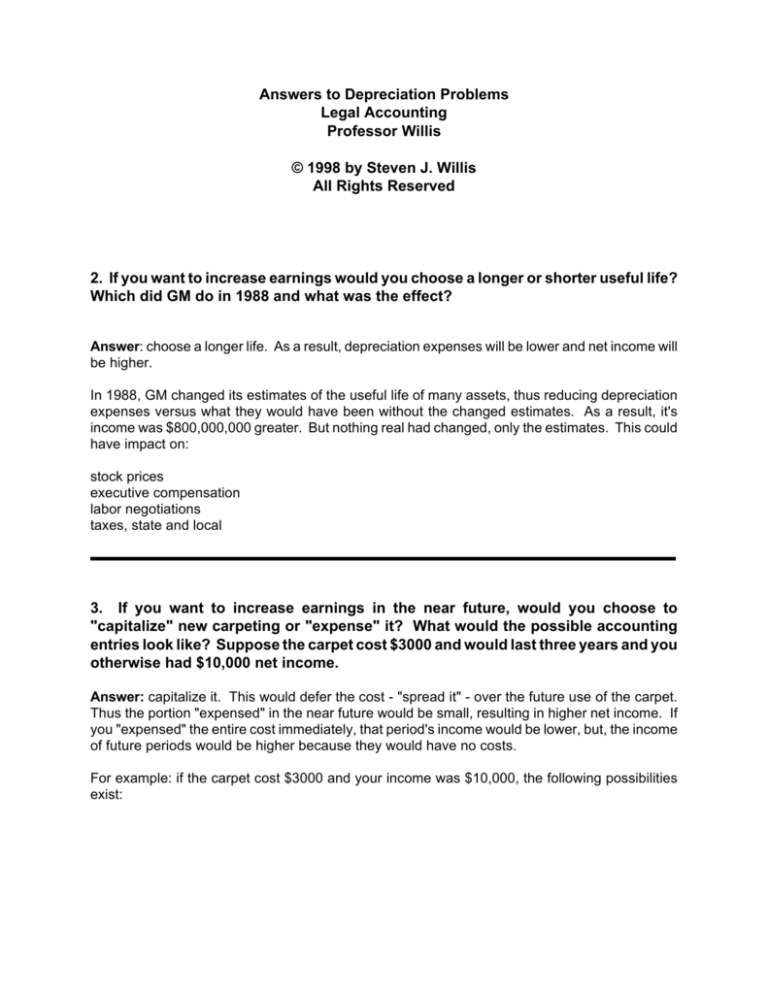
Answers to Depreciation Problems
Legal Accounting
Professor Willis
© 1998 by Steven J. Willis
All Rights Reserved
2. If you want to increase earnings would you choose a longer or shorter useful life?
Which did GM do in 1988 and what was the effect?
Answer: choose a longer life. As a result, depreciation expenses will be lower and net income will
be higher.
In 1988, GM changed its estimates of the useful life of many assets, thus reducing depreciation
expenses versus what they would have been without the changed estimates. As a result, it's
income was $800,000,000 greater. But nothing real had changed, only the estimates. This could
have impact on:
stock prices
executive compensation
labor negotiations
taxes, state and local
3. If you want to increase earnings in the near future, would you choose to
"capitalize" new carpeting or "expense" it? What would the possible accounting
entries look like? Suppose the carpet cost $3000 and would last three years and you
otherwise had $10,000 net income.
Answer: capitalize it. This would defer the cost - "spread it" - over the future use of the carpet.
Thus the portion "expensed" in the near future would be small, resulting in higher net income. If
you "expensed" the entire cost immediately, that period's income would be lower, but, the income
of future periods would be higher because they would have no costs.
For example: if the carpet cost $3000 and your income was $10,000, the following possibilities
exist:
A: Expense it currently:
Period one:
Carpet expense
Cash
Dr.
$3,000
Cr.
$3,000
Period two:
no entry
Period three:
no entry
This results in net income of:
Period 1
Period 2
Period 3
$10,000
( 3,000)
$ 7,000
$10,000
0
$10,000
$10,000
0
$10,000
B: Capitalize it and expense it over three years, on a straight-line basis:
Period One:
Carpet
Cash
Depr. Expense
Accum. Depr.
Dr.
$3,000
Cr.
$3,000
1,000
1,000
Period Two:
Depr. Expense
Accum. Depr.
1,000
1,000
Period Three:
Depr. Expense
Accum. Depr.
1,000
1,000
This results in net income of:
Period 1
Period 2
Period 3
$10,000
( 1,000)
$ 9,000
$10,000
( 1,000)
$ 9,000
$10,000
( 1,000)
$ 9,000
4. If you were to repair a Xerox machine in your office at a cost of $600 and you
expected the life of the machine to last another 12 months, how would you treat it
for accounting purposes if:
A. You want to correctly and precisely reflect each month's income.
B. You want to maximize earnings in the month you had it repaired.
C. You wanted to minimize earnings in the month you had it repaired.
Answer: A. Deduct $50 per month as an expense
B. Put off the repair or estimate a longer life or deduct nothing until you sell the machine
or even allocate it to the past. The second and third of these are wrong, and should not pass an
audit; however, many financial statements are not audited. The last is complicated and possibly
correct, in theory.
C. Expense it all that month.
5. Child support obligations are a function of the combined income of the parent's.
For example, if father earns $3,000 per month and mother earns $2,000, father must
pay 60% of the guideline amount to mother is she has primary residence, or mother
must pay 40% of that amount if father has primary residence. Suppose you
represent mother, who owns a dry cleaning business. Anticipating the child support
litigation, how might you advise her regarding making and/or anticipating some
significant repairs to some of the machinery? Or how might you advise her
regarding the purchase of some new machinery?
Answer: Make all the necessary and arguably needed repairs, expensing all the costs ASAP.
This will minimize income in the short run and will significantly decrease your share of child
support. In the longer run, your income will appear higher because you will have already
expensed these costs; however, the litigation may already be over.
Because I.R.C. § 179 permits taxpayers to deduct up to $17,500 of new business assets in the
year of purchase, without having to capitalize and depreciate anything, recommend that she
purchase some new equipment. Because most (perhaps all) state child support statutes use tax
returns as the beginning measure of income, her tax return will show substantially reduced net
income as a result of the purchase. This is inconsistent with GAAP, but nothing in the child
support statute likely requires consistency with GAAP.
Query: how would you react if you were on the other side?
You would have to examine things such as "repair expenses" and depreciation, particularly that
for tax purposes to see if it properly measured economic costs, matching those costs to the proper
income and to the proper period. Because "repairs" and depreciation and the purchase of new
equipment are easily controllable, these are the things likely to be manipulated.
6. Read Commissioner v. Idaho Power Co., 418 U.S. 1 (1974). How did the Court
require the company to treat depreciation on trucks used in constructing a building?
Answer: It had to compute the depreciation based on the useful life of the trucks, but then to
capitalize it as part of the building, and then to depreciate it over the useful life of the building.
For example, suppose the truck had a cost of $110,000, a useful life of ten years, and a salvage
of $10,000 and was used to construct the building for two years.
Truck
Cash
Depr. Exp.
Accum. Depr.
$110,000
$110,000
10,000
10,000
Adjusting entry:
Building under construction
Depr. Expense
$ 10,000
$ 10,000
7. Suppose you want to build a house (or represent the person wanting it built). The
contractor has a contract providing that his fee is "cost plus 10%." Is this clear?
Would you consider the contractor's salary (or part of it) as one of the costs? What
about the concrete, lumber, pipe, and such materials? What about overhead such
as a portion of the utilities used in his office and the salaries paid his office staff?
What about the fees paid an architect and laborers who worked on your ( or your
client's) house? What are some other overhead (indirect) costs that might present
a problem with such a contract? How might you re-word the contract to be more
clear?
Answer: I would want to pay for his direct costs - the bricks and mortar type, plus the direct labor.
The rest is overhead. The purpose of the 10% is that he must cover overhead and also have
some profit. If he has enough customers, 10% over cost from each should cover all overhead and
a reasonable profit. If he lacks sufficient customer over whom to "spread the overhead," that is
not my problem, but his. Car dealers and contractors and movie studios and universities are
notorious for this kind of "cost plus" contract. Be careful with the definition of "costs."
8. Describe the difference between "full costing" and "successful efforts" methods
used in the oil and gas industries. How do they differ? What do the accounting
entries look like?
Answer: Full costing (or "full absorption costing") capitalizes the costs of dry holes (unsuccessful
efforts), while "successful efforts" treats them as expenses.
9. What does the Court in Massey Motors, Inc. v. United States, 364 U.S. 92 (1960)
teach us? Did the taxpayer really make profits from the sale of the cars? What do
"useful life" and "salvage value" mean?
Answer: Depreciation is arbitrary and can have profound effects. Massey made no profits on the
cars, it merely over expensed costs, resulting in a low basis and subsequent gains on disposition.
A more realistic estimate of useful life and salvage - because they are based on the nearer term
- are less likely to be inaccurate.
10. Do the experts described in footnote 7 of the Massey case really disagree?
Consider a simple version. Suppose you have a machine with a cost of $1,000 and
an economic life of ten years and an economic salvage value in ten years of zero.
How would it be allocated on a straight line basis, if we use economic life and
ultimate salvage value? In contrast, suppose you knew that the machine would be
used by your particular business only for three years and would have an estimated
salvage value in three years of $700. How would the cost be allocated?
Answer: Both instances result in $100 of depreciation each year. This results because they each
assume level reductions in value at the same rate.
In Massey, however, the company assumed a level drop in value each year for four years and
zero value at the end of four years. This resulted in depreciation of $515 per year, or $42.92 per
month. The government assumed a useful life of 17 months and a salvage value of $1,325 (with
an original cost of $1,650), which computed to depreciation of $325 over 17 months, or $19.12
per month. The company may have been correct that an extra 31 months of usage would result
in a zero value; however, that is irrelevant because it would only use it for 17 months. Because
each month, in reality, will not be the same, the differing estimates of salvage and useful life result
in more and more imprecision, the farther into the future the estimates attempt to reach.
11. Depreciation methods:
straight line
units of production
inventory method
accelerated methods:
declining balance
double declining balance
SYD (sum of the years' digits) method
12. Briefly describe the history of tax depreciation
Answer: To be added
The faster the tax code permits depreciation, the lower a TP's taxes will be in the first years after
the purchase of a new asset. Arguably, such lower taxes encourage investment, which in turn
improves the economy and provides jobs. These political considerations, however, have nothing
to do with "clear reflection of income." Instead, they are intended to balance the maximization of
both revenues and economic activity.
In contrast, GAAP does not care about tax revenues or economic activity; instead, it merely cares
about reflecting fairly what happened to a particular entity. Thus depreciation should be based
on realistic estimates of loss in asset value. Traditional methods attempt to accomplish this. But,
many legal issues define "cost" or "income" by referring to tax returns and tax definitions as a
basis for legal consequences. While those are relevant, they should not be controlling. You
should look behind the tax figures to see if they comply with GAAP and whether they clearly reflect
income.
13. Describe "modified ACRS" as currently in use for tax purposes. Evaluate it in
terms of GAAP.
Method:
Double Declining Balance
Salvage:
Zero Salvage Assumed
Convention:
Mid-year convention (presumes everything purchased on July 1 and
disposed of on June 30)
"Class Life"
Tax Life
1-4
5-9
10-15
16-19
20-24
over 25
residential rental
Non-residential rental
RR grading tunnel bore
3
5
7
10
15
20
27.5
39
50
The left column lists economic (real) lives.
The right column lists the presumed tax
life.
Example: five year property:
Year 1
Year 2
Year 3
Year 4
Year 5
20%
32%
19.2%
11.52%
11.52%
Year 6
5.76%
These are the actual percentages used for
five year property. The year one amount
(20%) is ½ of twice the straight-line rate (½
of 40%). The year two amount is 40% of
80% (the adjusted basis: 100% minus
20%). The year three amount is 40% of
48% (the adjusted basis: 100% minus 20%
minus 32%). The year four amount is 40%
of 28.8% (the adjusted basis: 100% minus
20% minus 32% minus 19.2%). The year
five and six amounts reflect a switch to the
straight-line method.




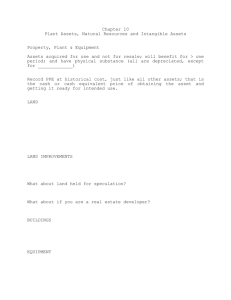
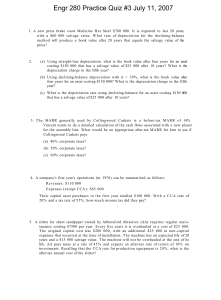
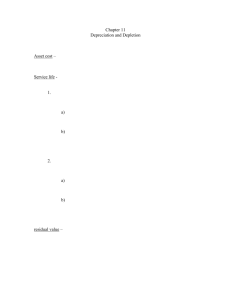
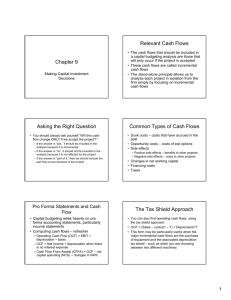
![Quiz chpt 10 11 Fall 2009[1]](http://s3.studylib.net/store/data/005849483_1-1498b7684848d5ceeaf2be2a433c27bf-300x300.png)
